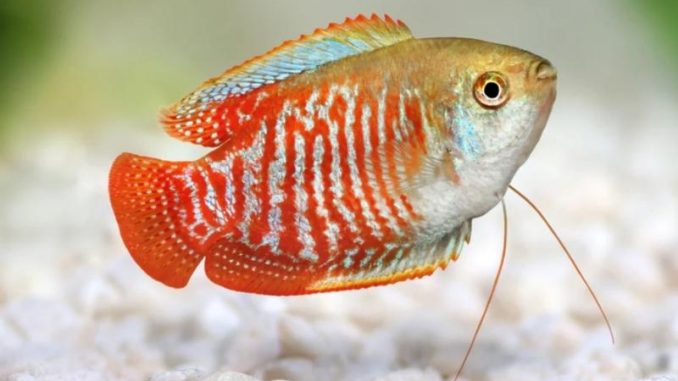
Gouramis are peaceful fish with feisty personalities. Found throughout southern and eastern Asia, gouramis are popular in the pet trade because the fish are easy to care for and enjoy the company of similarly-sized fish.
There are three common gourami colors: pink-orange, silvery-green, and mottled/piebald. The most popular gouramis for fishkeepers are listed below.
TABLE OF CONTENTS
Kissing Gourami
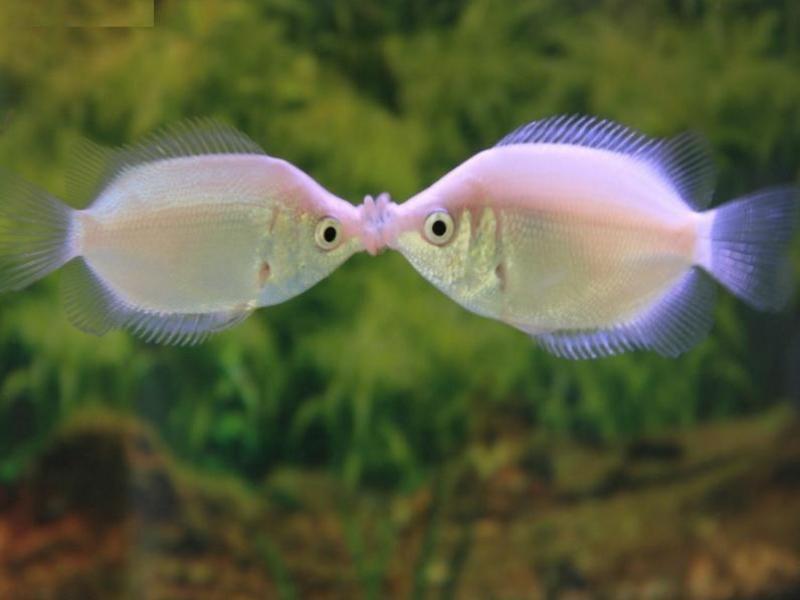
| Care level: | Temperament: | Color: | Lifespan: | Size: |
| Easy | Peaceful | Pink-orange with white spots and a horizontal black stripe | 8 years | 4 inches |
| Water temperature: | Water pH: | Tank size: | Diet: | Scientific name: |
| 74–82°F | 6.5–7.0 pH | 20 gallons | Omnivore | Trichogaster leeri |
Kissing gouramis get their names from their puckered lips and their unique “kissing” behavior. Although kissing gouramis look like they’re kissing one another, the fish are fighting with their mouths.
The most common color for kissing gourami is pale pink, but green kissing gouramis are available too.
Take care when housing kissing gouramis with other fish because kissing gouramis are territorial and occasionally quarrelsome.
Pearl Gourami
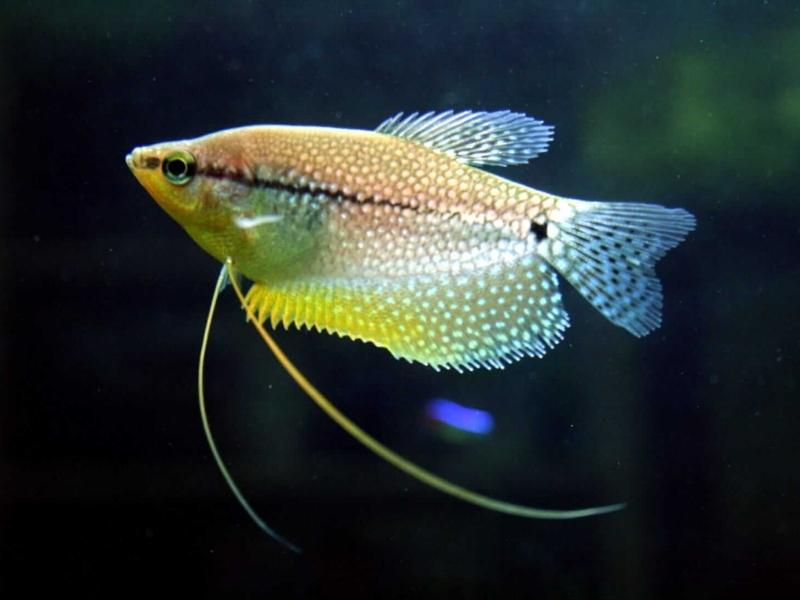
| Care level: | Temperament: | Color: | Lifespan: | Size: |
| Easy | Peaceful | Pink-orange with white spots and a horizontal black stripe | 8 years | 4 inches |
| Water temperature: | Water pH: | Tank size: | Diet: | Scientific name: |
| 74–82°F | 6.5–7.0 pH | 20 gallons | Omnivore | Trichogaster leeri |
Pearl gouramis have flowing fins and orange bodies with white spots and a horizontal black line from the mouth to the tail. The pearl gouramis fish get their name because their coloring and pattern are reminiscent of mother of pearl.
Pearl gouramis are the hardiest and most adaptable of all gourami fish, and are the easiest gouramis to take care of.
You can keep pearl gouramis in a variety of tropical water conditions and with a variety of peaceful tankmates, including similarly-sized and smaller schooling fish.
Giant Gourami
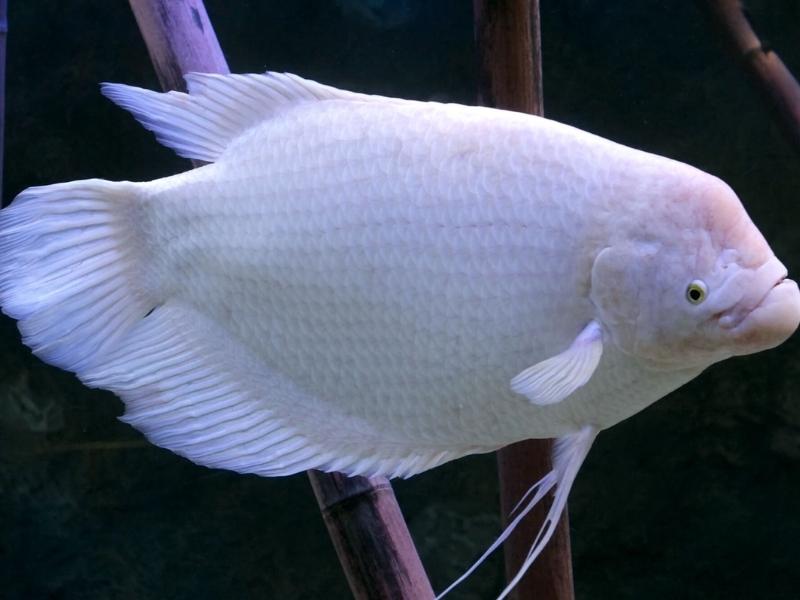
| Care level: | Temperament: | Color: | Lifespan: | Size: |
| Easy | Peaceful | Soft yellow with pale blue stripes | 5 years | 20 inches |
| Water temperature: | Water pH: | Tank size: | Diet: | Scientific name: |
| 68–86°F | 6.8–7.8 pH | 200 gallons | Omnivore | Osphronemus goramy |
Giant gouramis are the largest gourami species, reaching upwards of 16 inches in length. These fish require large tanks of at least 200 gallons, with plenty of space to swim.
The most common color for giant gouramis is pale yellow/white, but the fish are also available in shades of silver.
You can house giant gouramis as single fish because giant gouramis aren’t schooling fish. Giant gouramis are friendly and sociable, and some giant gouramis enjoy physical contact such as petting.
Because of the giant gourami’s large size, this fish requires significantly more food than smaller gourami species.
Honey Gourami
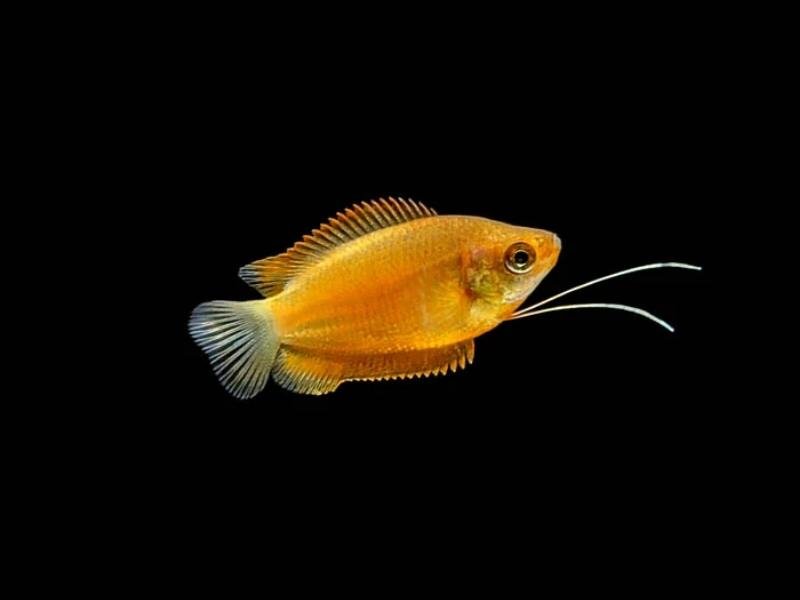
| Care level: | Temperament: | Color: | Lifespan: | Size: |
| Easy | Peaceful | Honey-orange (males), silvery-gray (females) | 8 years | 3 inches |
| Water temperature: | Water pH: | Tank size: | Diet: | Scientific name: |
| 71–82°F | 6.0–7.5 pH | 10 gallons | Omnivore | Trichogaster chuna |
Honey gouramis, otherwise known as sunset gouramis, are a hardy, beginner-friendly gourami variety. Not all honey gouramis are honey-colored. Males are honey-gold with black markings, but females are silvery-gray.
A tank with plenty of swimming space and plants is ideal for honey gourami. Honey gouramis are slow-swimming and prefer to be housed with a small school of other honey gouramis.
Other good tankmates for honey gouramis are danios and corydoras.
Gold Gourami
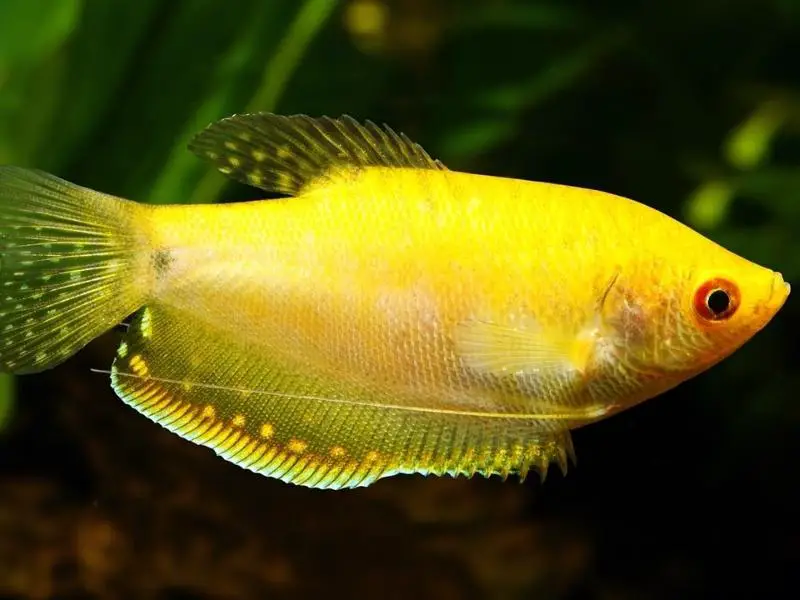
| Care level: | Temperament: | Color: | Lifespan: | Size: |
| Easy | Semi-aggressive | Yellowy-orange with pale spots | 6 years | 6 inches |
| Water temperature: | Water pH: | Tank size: | Diet: | Scientific name: |
| 73–82°F | 6.0–8.0 pH | 35 gallons | Omnivore | Trichopodus trichopterus |
Gold gouramis are a variation of blue gouramis and aren’t found in the wild. The fish are moderately aggressive and should live only with similarly-sized peaceful fish species, like mollies and loaches.
Gold gouramis are community fish, and housing the fish alone can lead to stress.
The color and vibrancy of a gold gourami depend on the fish’s mood. A stressed gold gourami has muted colors, while happy gold gouramis look bold and vibrant.
Gold gouramis are slow-moving fish that explore all areas of the tank.
Moonlight Gourami
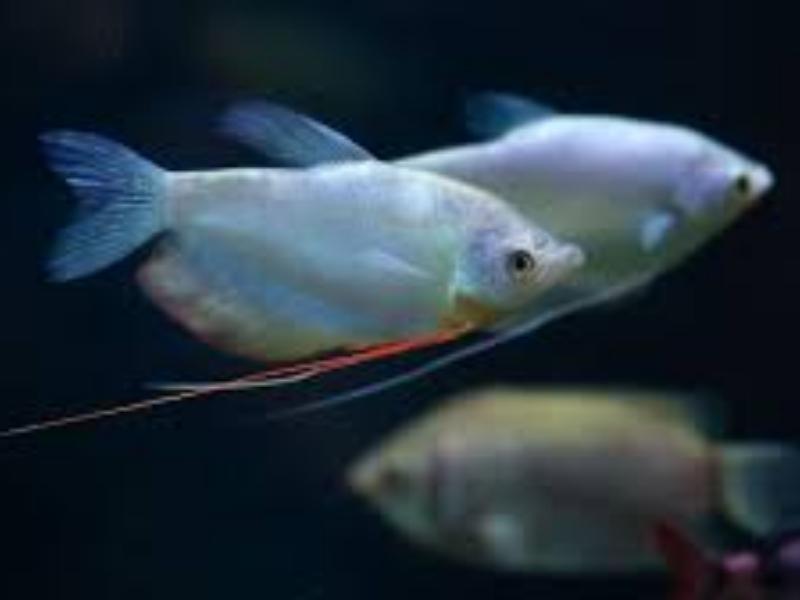
| Care level: | Temperament: | Color: | Lifespan: | Size: |
| Moderate | Peaceful | Silver with green iridescence | 4 years | 5 inches |
| Water temperature: | Water pH: | Tank size: | Diet: | Scientific name: |
| 77–86°F | 6.0–7.0 pH | 20 gallons | Omnivore | Trichopodus microlepis |
Moonlight gouramis are medium-sized freshwater fish with unique silvery-blue coloring and almost-transparent fins. Although moonlight gouramis are common in the wild, the fish aren’t always available in pet stores.
As peaceful fish, moonlight gouramis are best suited to diverse tank communities. The fish swim slowly and gracefully, occupying the top and the middle of the tank.
Moonlight gouramis have a labyrinth organ, which allows the fish to swim to the top of the tank to breathe oxygen from the air above.
Blue Gourami/Three-Spot Gourami
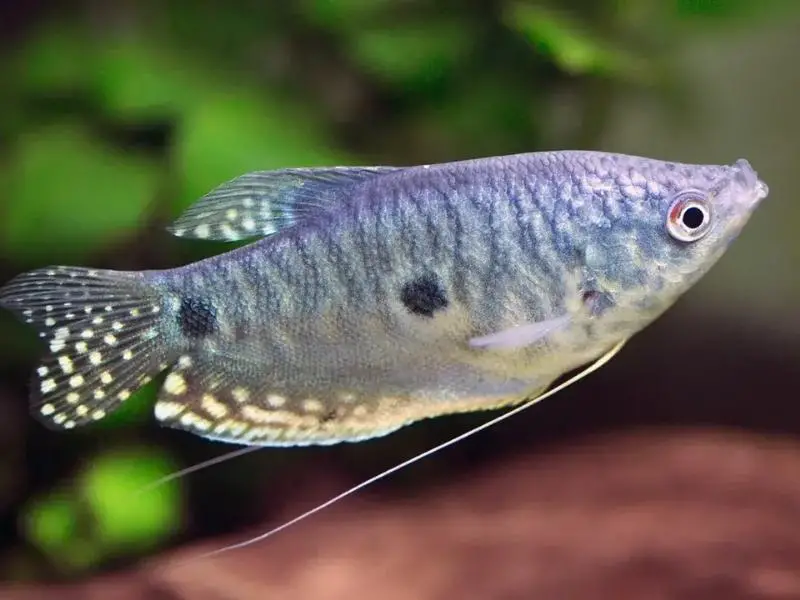
| Care level: | Temperament: | Color: | Lifespan: | Size: |
| Easy | Peaceful | Silvery-blue to deep, rich blue | 5 years | 6 inches |
| Water temperature: | Water pH: | Tank size: | Diet: | Scientific name: |
| 72–82°F | 7.0–8.0 pH | 20 gallons | Omnivore | Trichopodus trichopterus |
Blue gouramis are one of the most popular and widely-available gourami types. The fish are peaceful and easy to care for, and thrive in a community tank.
Blue gouramis are best known for their beautiful blue bodies, and each blue gourami is a unique shade of blue.
They prefer a slow-moving water flow. The fish swim close to the top of the tank, occasionally emerging from the water to breathe oxygen from the air.
As slow-swimming fish, blue gouramis shouldn’t live in an aquarium that also houses aggressive fin-nippers.
They are also sometimes referred to as three-spot gouramis.
Snakeskin Gourami
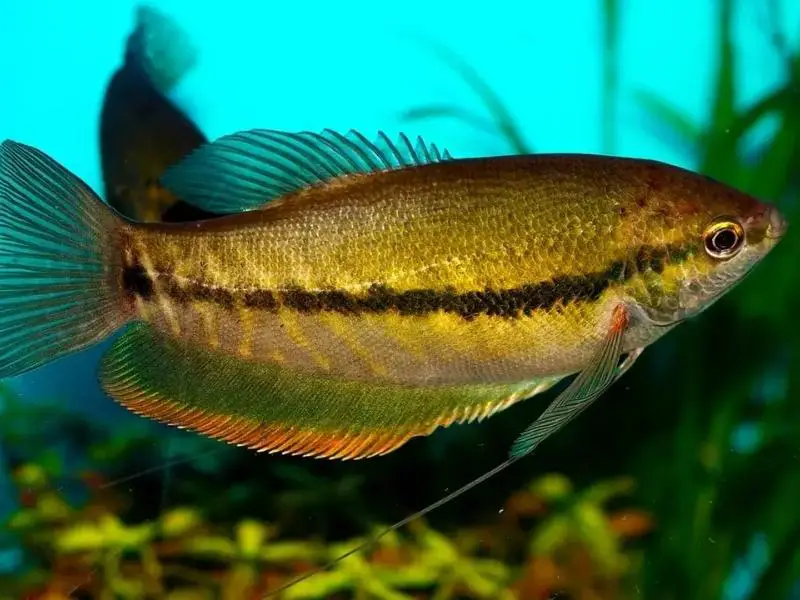
| Care level: | Temperament: | Color: | Lifespan: | Size: |
| Easy | Peaceful | Olive | 6 years | 10 inches |
| Water temperature: | Water pH: | Tank size: | Diet: | Scientific name: |
| 72–86°F | 5.8–8.0 pH | 20 gallons | Omnivore | Trichopodus pectoralis |
Snakeskin gouramis get their name because of the snakeskin-like pattern on the fishes’ bodies. Although large, snakeskin gouramis are peaceful fish that can live alongside most similarly-sized peaceful fish including barbs, loaches, and corydoras.
Don’t house snakeskin gouramis with small fish, because these gouramis might see the small fish as live prey.
Snakeskin gouramis prefer plenty of space to swim, and overstocking the tank can bring out aggressive tendencies in this gourami type.
Sparkling Gourami
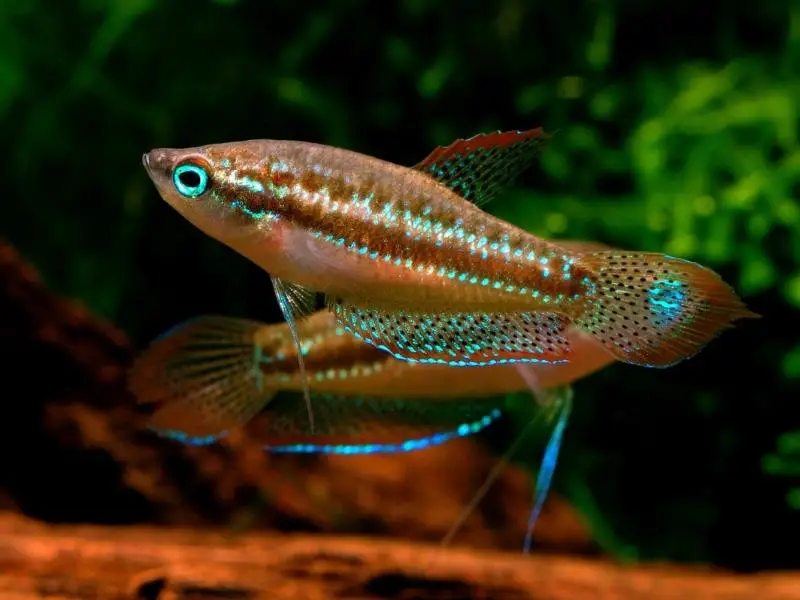
| Care level: | Temperament: | Color: | Lifespan: | Size: |
| Moderate | Peaceful | Deep silver with bright spots | 5 years | 1.6 inches |
| Water temperature: | Water pH: | Tank size: | Diet: | Scientific name: |
| 72–80°F | 6.0–8.0 pH | 15 gallons | Omnivore | Trichopsis pumila |
Sparkling gouramis, otherwise known as pygmy gouramis, are the smallest gourami variety, reaching less than 2 inches in length.
These silver, glittery fish have blue and green hues on their bodies, and stand out in aquariums despite their small size.
Although sparkling gouramis aren’t a schooling species, the fish are happiest when living in groups of at least five.
Sparkling gouramis swim in all areas of the tank and should be housed with peaceful, similarly-sized fish like tetras and corydoras.
As one of the few vocal fish breeds, sparkling gouramis chirp and croak to express happiness.
Dwarf Gourami
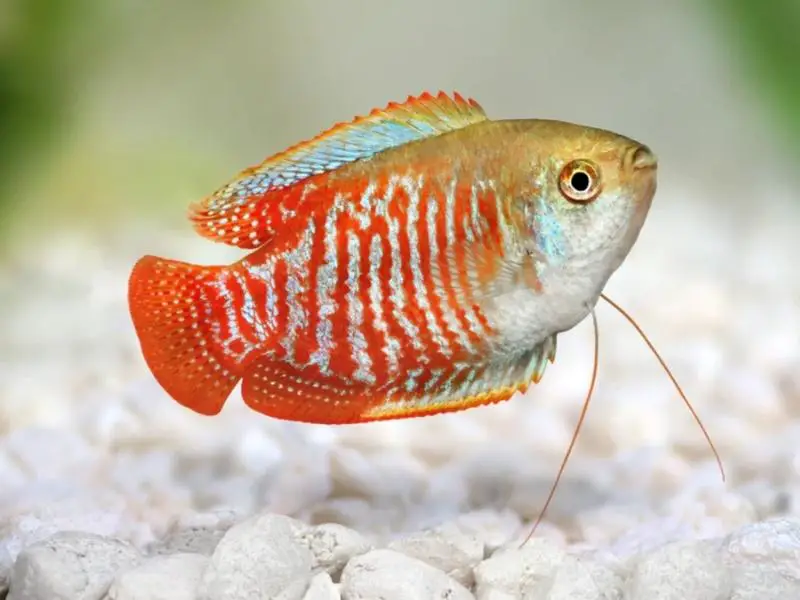
| Care level: | Temperament: | Color: | Lifespan: | Size: |
| Moderate | Peaceful | Multicolored | 5 years | 4.5 inches |
| Water temperature: | Water pH: | Tank size: | Diet: | Scientific name: |
| 77–78.5°F | 6.0–8.0 pH | 10 gallons | Omnivore | Trichogaster lalius |
Dwarf gouramis are a beautiful, beginner-friendly variety of gourami, available in a rainbow of colors.
As hardy fish, dwarf gouramis can survive in poor water conditions and varying temperatures. You can find dwarf gouramis in several colors, including brilliant red and deep blue.
You can house dwarf gouramis in community aquariums with other small fish, or in mini aquariums. Dwarf gouramis are peaceful, but the fish don’t tolerate fin-nipping or bullying.
Chocolate Gourami
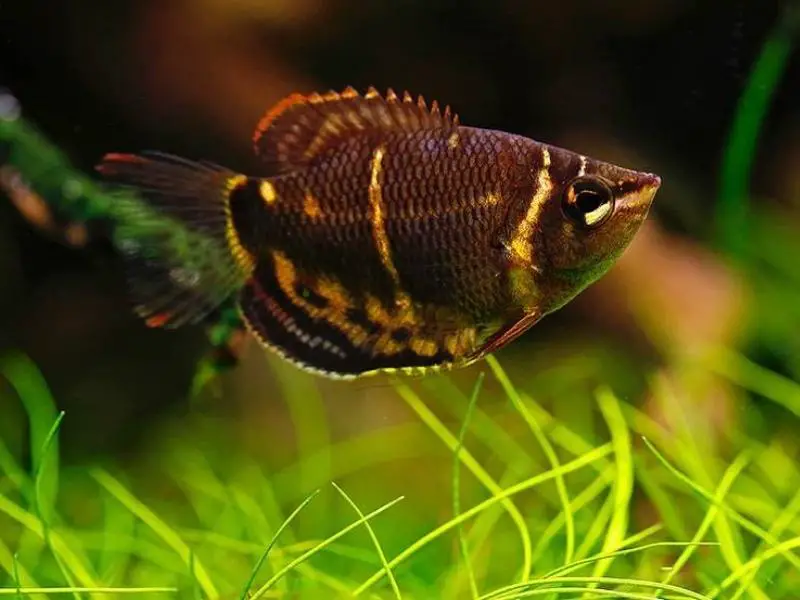
| Care level: | Temperament: | Color: | Lifespan: | Size: |
| Difficult | Peaceful | Brown with pale brown or yellow stripes | 4 years | 2.5 inches |
| Water temperature: | Water pH: | Tank size: | Diet: | Scientific name: |
| 77–84°F | 4.0–6.0 pH | 30 gallons | Omnivore | Sphaerichthys osphromenoides |
Chocolate gouramis have deep brown, chocolate-colored bodies with pale brown or yellow stripes and pops of red.
These peaceful fish enjoy the company of other chocolate gouramis and prefer to live in groups of at least two.
Other fish that can be housed with chocolate gouramis are loaches, danios, and rasboras.
Beginners shouldn’t consider chocolate gouramis because these fish are less hardy than other gourami species, preferring acidic water and humid tank conditions.
Chocolate gouramis require planted tanks, but keeping plants can be difficult in acidic waters.
Paradise Gourami
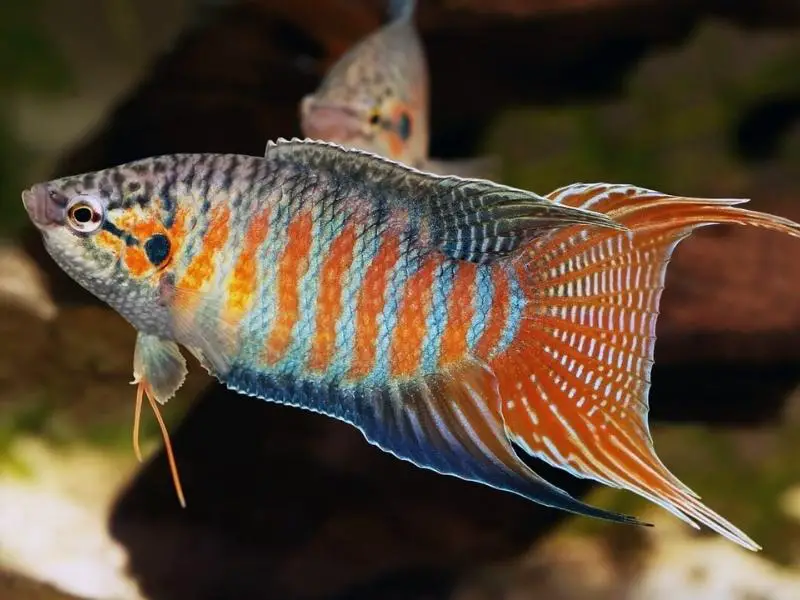
| Care level: | Temperament: | Color: | Lifespan: | Size: |
| Moderate | Aggressive | Red and blue stripes | 10 years | 2.5 inches |
| Water temperature: | Water pH: | Tank size: | Diet: | Scientific name: |
| 70–82°F | 6.0–8.0 pH | 20 gallons | Omnivore | Macropodus opercularis |
Paradise gouramis have orangey-red bodies with blue stripes, and the fish’s coloring intensifies during the breeding season.
Because of their beautiful appearance and long, flowing fins, paradise gouramis are popular amongst fishkeepers. However, paradise gouramis are aggressive fish that attack and kill other fish.
You should only house paradise gouramis with large, peaceful fish, like common and comet goldfish, and clown loaches. Paradise gouramis prefer tropical water conditions and heavily-planted tanks.
Samurai Gourami
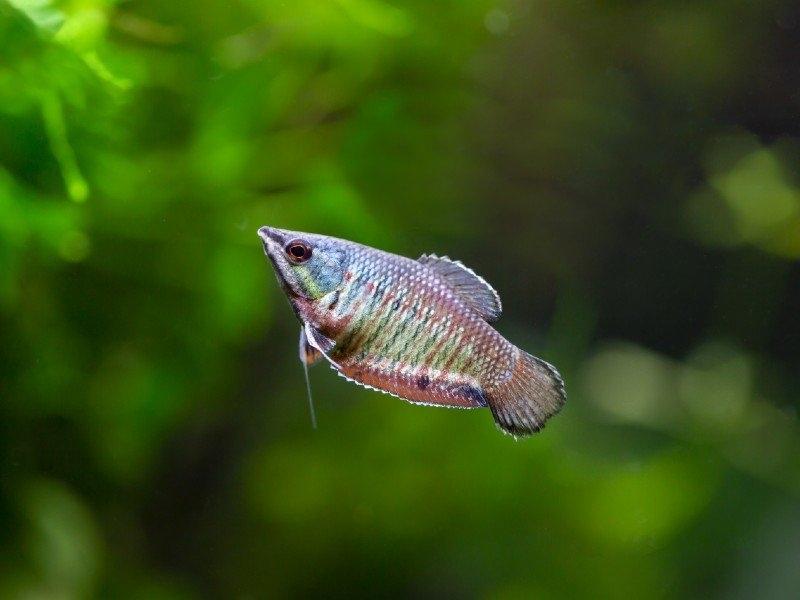
| Care level: | Temperament: | Color: | Lifespan: | Size: |
| Hard | Timid | Red and green with bold stripes | 8 years | 2.2 inches |
| Water temperature: | Water pH: | Tank size: | Diet: | Scientific name: |
| 70–80°F | 4.0–5.0 pH | 20 gallons | Omnivore | Sphaerichthys vaillanti |
Samurai gouramis have vibrant iridescent green coloration, and females have green and red vertical bars on their bodies. This gourami type requires acidic water with a low mineral and nutrient content.
Female samurai gouramis are more dominant than males. Samurai gouramis are shy, peaceful fish that prefer lots of plants, caves, and driftwood to hide in.
As mouthbrooders, male samurai gouramis use their mouths to store the female’s eggs until the eggs are ready to hatch.
Licorice Gourami
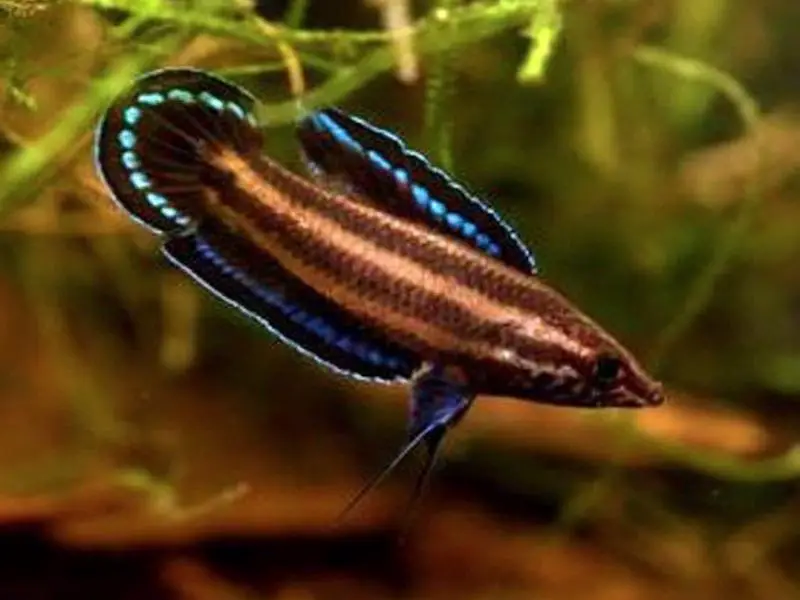
| Care level: | Temperament: | Color: | Lifespan: | Size: |
| Moderate | Peaceful, occasionally aggressive | Silver with black vertical stripes; blue, green, and red hues | 6 years | 2.5 inches |
| Water temperature: | Water pH: | Tank size: | Diet: | Scientific name: |
| 75–82°F | 4.0–6.5 pH | 20 gallons | Omnivore | Sphaerichthys vaillanti |
Licorice gouramis are a small gourami species, reaching up to 2.5 inches in length. The fish’s name comes from their licorice-like colorings and markings.
Licorice gouramis prefer slow-moving currents and plenty of plants and caves in the tank.
Although licorice gouramis are peaceful, the fish prefer to live in a tank with fish of the same species. Other-species tank mates should be peaceful, small, and slow-moving, with no bullying tendencies.
Opaline Gourami
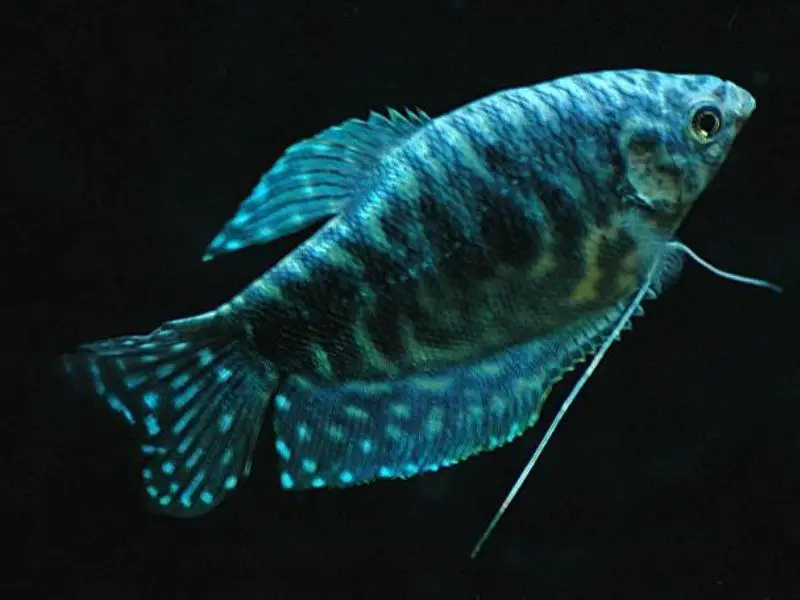
| Care level: | Temperament: | Color: | Lifespan: | Size: |
| Easy | Peaceful, occasionally aggressive | Blue with a pale marbled pattern | 6 years | 6 inches |
| Water temperature: | Water pH: | Tank size: | Diet: | Scientific name: |
| 73–82°F | 6.0–8.8 pH | 35 gallons | Omnivore | Trichopodus trichopterus |
Opaline gouramis are a color morph of blue gouramis. The fish have light blue bodies with dark blue marbling, and dark spots near the tail end.
Opaline gouramis are labyrinth fish that swim to the surface to get air.
As moderately aggressive fish, opaline gouramis can be territorial, and fight with other males when they feel threatened.
You should house opaline gouramis with similarly-sized, non-aggressive fish like barbs and loaches.
Choosing & Caring For Different Types of Gouramis
Gouramis are beautiful, diverse fish that add color and personality to a home aquarium.
As long as you use good tank filtration, change 25% of the water every two weeks, and maintain consistent water parameters, you will easily raise happy, healthy gouramis.
Some gouramis are more difficult to care for than others. If you’re a beginner aquarist, opt for gouramis that have low care needs, like pearl gouramis, blue gouramis, and dwarf gouramis.
Experienced aquarists should be comfortable keeping gouramis with challenging care needs, like snakeskin gouramis and samurai gouramis.
Female gouramis tolerate other gourami types better than males. Males treat one another aggressively, so you shouldn’t keep different types of male gouramis together.
Only mix female gouramis in large tanks with plenty of swimming space and decoration. Honey gouramis and sparkling gouramis are the best gourami species to house together.

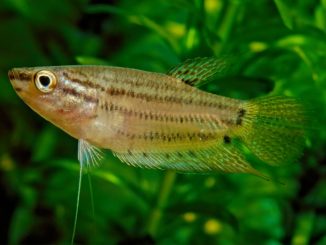
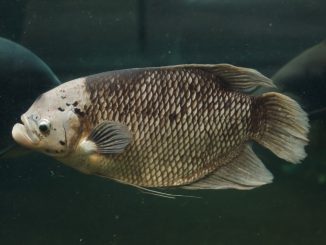

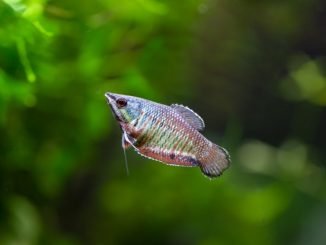
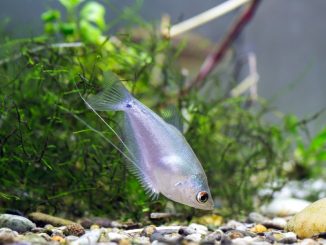
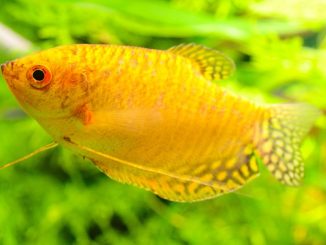
Excellent article with explicit info for each fish. Great Photo’s!